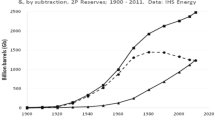Abstract
Combining geological knowledge with proven plus probable (“2P”) oil discovery data indicates that over 60 countries are now past their resource-limited maxima of conventional oil production. The data show that the maximum of global conventional oil production is imminent. Many analysts who rely on only proven (“1P”) oil reserves data draw a very different conclusion. But proven oil reserves data contain no information about the true size of discoveries, being variously underreported, overreported, and not reported. In addition to conventional oil, the world contains large quantities of nonconventional oil. However, many current detailed models show that past the conventional oil peak the nonconventional oils will not come onstream fast enough to offset the decline in conventional oil production.
The paper concludes that the likely dates of hydrocarbon production maxima are:
Non-Organization of Petroleum Exporting Countries | Conventional oil | Now–2015 |
Global | Conventional oil | 2010–2020 |
Global | All oil | 2015–2025 |
Global | Oil + gas | 2015–2030 |
Global | Gas | 2020–2040 |


Similar content being viewed by others
References
Bauquis, P.-B. (2003). What energies for transportation in the 21st century? Presentation at the ASPO 2nd International Workshop on Oil Depletion (IWOOD-2003), IFP, Paris, May 26-27.
Bentley, R. W., & Boyle, G. A. (2008). Global oil production: forecasts and methodologies. Environment and Planning B: Planning and Design, 35, 609–626.
Bentley, R. W., Mannan, S. A., & Wheeler, S. J. (2007). Assessing the date of the global oil peak: the need to use 2P reserves. Energy Policy, 35, 6364–6382. Elsevier.
BGR (2002). Reserven, Ressourcen und Verfügbarkeit von Energierohstoffen, (Bundesanstalt für Geowissenschaften und Rohstoffe) Germany.
Campbell, C. J. (1991). The Golden Century of Oil: 1950-2050. The Depletion of a Resource. Springer.
Campbell, C. J., & Sivertson, A. (2003). The ‘Campbell-Uppsala’ model. See website: www.peakoil.net, or: Campbell, C J, The Essence of Oil & Gas Depletion. Multi-Science Publishing, Essex, UK; ISBN 0 906522 19 6, pp. 233-254.
Campbell, C. J., & Heapes, S. (2008). An atlas of oil and gas depletion. West Yorkshire: Jeremy Mills Publishing.
Deffeyes, K. S. (2005). Beyond Hubbert’s peak. Princeton University Press.
Energyfiles Ltd. (2006). (a). Smith, M R, The World Oil Supply Report 2004-2050, 3rd Edn, Douglas-Westwood Ltd. (b). Smith, M R, The World Gas Supply Report 2004-2025, 1st Edn., Douglas-Westwood Ltd. (c). Web: www.energyfiles.com, e-mail: admin@energyfiles.com
Energyfiles (2007). See Energyfiles data on the map on website of David Strahan: www.lastoilshock.com/map.html.
Hubbert, M. K. (1956). Nuclear energy and fossil fuels. Drilling and production practice; The American Petroleum Institute, pp. 7–25.
IEA (1998; 2000; 2004; 2005; 2007; 2008). World energy outlook. Paris: International Energy Agency
IHS Energy, USA (2000). ‘PEPS’ database of oil data by country. Available on a commercial basis.
Miller, R. G. (2004). Miller’s unofficial BP model and its results were presented at an Institute of Energy, Northern Ireland Branch meeting, 24th February, 2004. Miller’s (2008) model is potentially available on request from the author.
Odell, P. (2004). Why carbon fuels will dominate the 21st century energy economy. UK: Multi-Science Publishing.
PFC Energy (2005). Presentation at the ‘Global Oil Depletion Debate’, Energy Institute, London, 2005; also personal communications.
Shell (2003). Scenario modelling based on data in P-R Bauquis’ presentation at IWOOD 2003, Paris. (See www.peakoil.net).
Skrebowski, C. (2008). In The Oil Crunch. Securing the UK’s energy future. First report from the UK Industry Taskforce on Peak Oil and Energy Security. www.peakoiltaskforce.net.
Sorrell, S. (2009). Ed. Global Oil Depletion. Report for the United Kingdom Energy Research Cntre (UKERC), London, UK. Forthcoming 2009. See: www.ukerc.ac.uk.
USGS (2000). United States Geological Survey, World Petroleum Assessment 2000;/http://pubs.usgs.gov/dds/dds-060/S.
Ward, B., & Dubois, R. (1972). Only one earth: the care and maintenance of a small planet (p. 1972). UK: Penguin Books.
Author information
Authors and Affiliations
Corresponding author
Rights and permissions
About this article
Cite this article
Bentley, R.W. The expected dates of resource-limited maxima in the global production of oil and gas. Energy Efficiency 3, 115–122 (2010). https://doi.org/10.1007/s12053-009-9063-9
Received:
Accepted:
Published:
Issue Date:
DOI: https://doi.org/10.1007/s12053-009-9063-9




